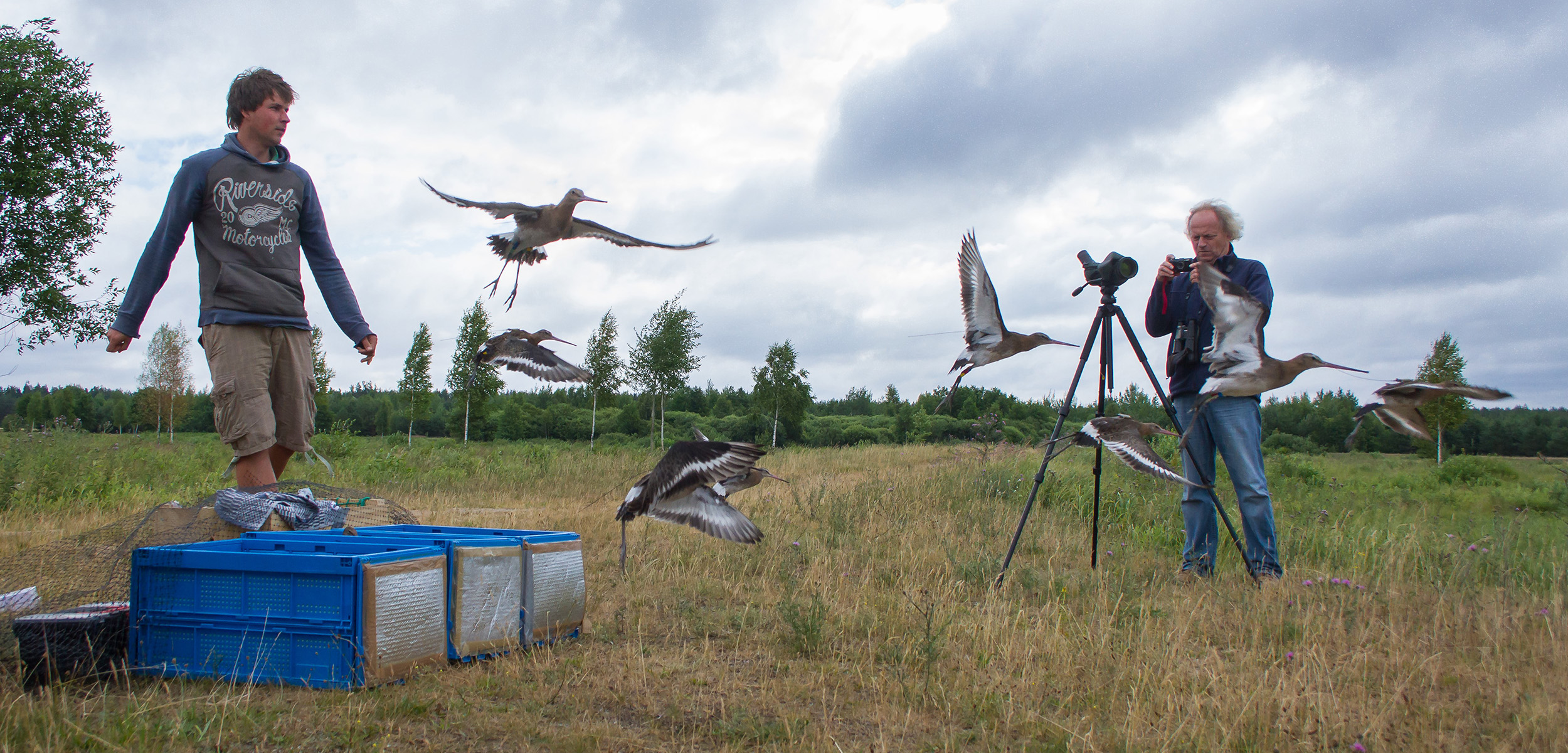Birds of a Feather Flock … With Whoever Is Nearby
Chart your own course, or stick with the group? Migrating shorebirds choose the latter.
Article body copy
In a dimly lit barn in the Netherlands, a tiny ball of fluff tottering on comically oversized feet pecks at some chicken feed before settling in for a nap under a heat lamp. This baby black-tailed godwit is only a few days old, and it needs the rest. For in a few weeks, it will set off on an extraordinary journey. First, it will be carefully loaded into the back of a van with nine other young godwits and driven 1,000 kilometers east to Poland. From there, it will join the local black-tailed godwits on a vast migration, traveling 3,600 kilometers south to sub-Saharan Africa.
In the process, this little bird will help answer a fundamental question that has been troubling shorebird biologist Theunis Piersma for more than 30 years: are godwits born with their migratory routes hard-coded into their genes, or do they learn it from other birds?
For decades, scientists have leaned toward genetics. But based on the results of his experiment with young godwits, Piersma argues scientists should be giving the role of social learning a closer look.
Piersma first became skeptical of the idea that migration routes are genetically programmed while a graduate student at the Netherlands’ University of Groningen in the 1990s. At the time, new research was showing that one migratory shorebird, the red knot, had only recently—evolutionarily speaking—diverged into various subspecies. Most of this separation, says Piersma, happened after the end of the most recent ice age, roughly 12,000 years ago. Red knot subspecies follow different migration routes, and Piersma didn’t think there had been enough time for those different routes to have developed through natural selection, which would be necessary if those paths were dictated by genes. “So this became the big quest,” he says. “How did migratory flyways evolve?”
Like red knots, black-tailed godwits are long-distance migrants. These elegant chestnut-colored shorebirds breed in wetlands and coastal areas across Eurasia, with different populations preferring different migration routes and overwintering areas. Piersma wanted to test godwits’ choice of migration route through a translocation study—moving young godwits from one population to another to see whether they’d learn the migratory route of their new neighbors or continue instinctively using the route of their parents.
Initially, Piersma struggled to get funding. But in 2014, he was awarded the Netherlands’ prestigious Spinoza Prize for his work on the ecology of shorebird migration. This scientific accolade came with a €2.5-million (US $2.7-million) purse that he could use to research whatever he wanted. He immediately set to work.
Piersma and his colleagues hand-reared dozens of wild black-tailed godwits they collected from nests in the Netherlands’ north. They outfitted the birds with tiny transmitters and released them to migrate. Half were let go from their home turf; the others were trucked to Poland. Every 36 hours, the birds’ solar-powered transmitters reported their locations to passing satellites—and on to the biologists’ computers.
Tracking the birds’ progress, Piersma quickly proved his hunch that social coordination, not genes, is driving the godwits’ migration. Throughout 2015 and 2016, the scientists tracked 80 godwits, and all but one of the birds trucked to Poland assumed the Polish birds’ route.
“It was super gratifying,” says Piersma. How exactly the birds are learning from each other remains unclear, but Piersma suspects the godwits are not simply following the crowd. Instead, he suspects they are somehow sharing information of their route with each other before they leave.
Piersma believes that the broad takeaway of this work—that scientists have been overvaluing the contributions of genes to bird migration—extends beyond shorebirds to other groups, such as songbirds. But unlike shorebirds, which are social and long lived, songbirds live only a few years and don’t migrate in organized flocks, giving them fewer opportunities to learn from their peers. Scientists studying songbirds have found multiple genes that appear to be related to their migration routes and destinations.
“I think it makes sense that social cues are likely a strong component of migration in black-tailed godwits,” says Dave Toews, an evolutionary ecologist at Pennsylvania State University who wasn’t involved in the research, and whose own studies identified a single gene linked to differences in wintering sites between two closely related warbler species. But, he adds, “I don’t think that negates all of the [genetic] research that has been done on Swainson’s thrushes, blackcaps, [and other songbirds].”
In a changing world, though, Piersma believes godwits’ ability to learn new migration routes may make them more adaptable. “That migration is cultural,” he says, means “you can learn new things, you can invent things.” Godwits will likely need that flexibility in the decades to come.

